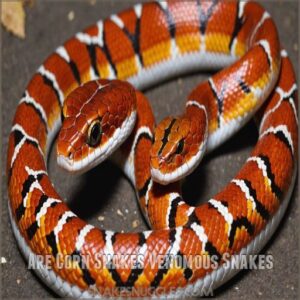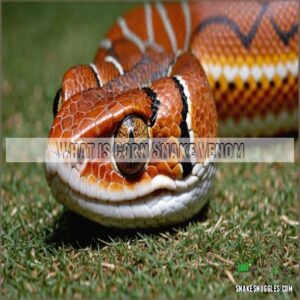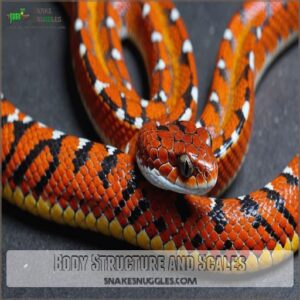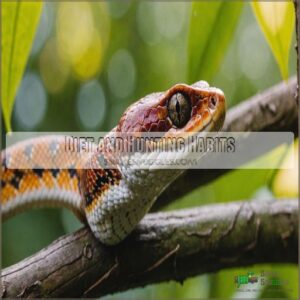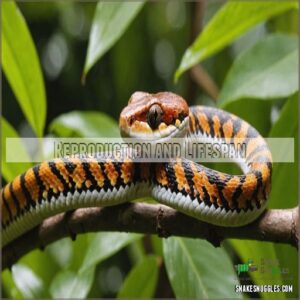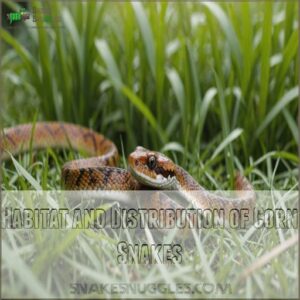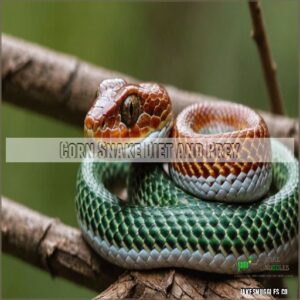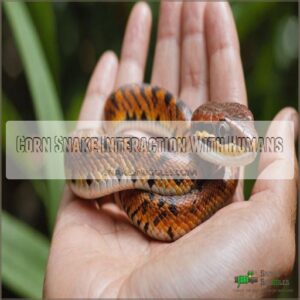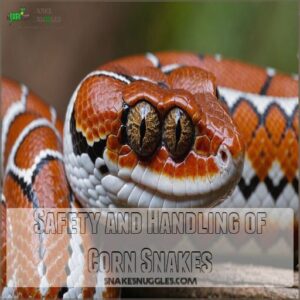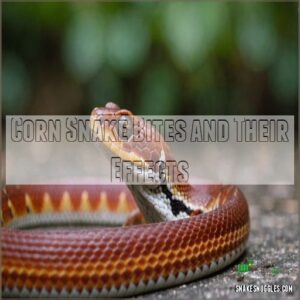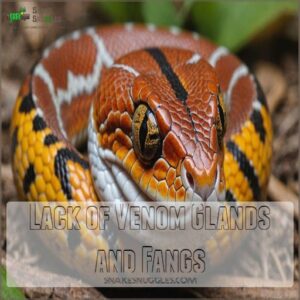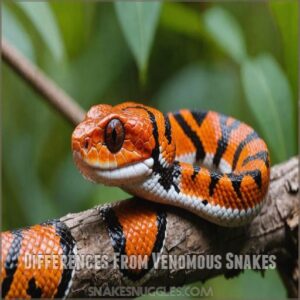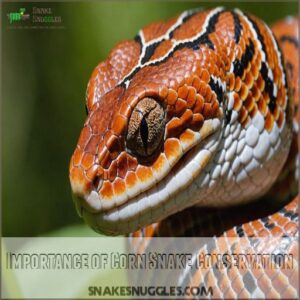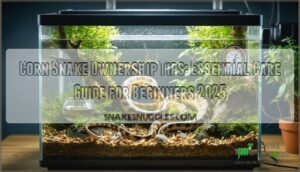This site is supported by our readers. We may earn a commission, at no cost to you, if you purchase through links.
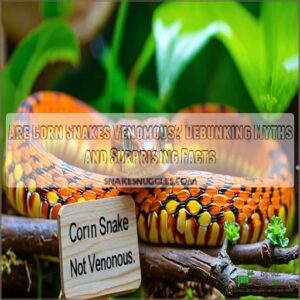 No, corn snakes aren’t venomous – they’re actually one of the most gentle snake species you’ll encounter.
No, corn snakes aren’t venomous – they’re actually one of the most gentle snake species you’ll encounter.
Like your household vacuum cleaner, they’re expert constrictors who squeeze their prey rather than using venom.
While they can bite if startled (with a striking range of about half their body length), their bite feels similar to a paper cut and rarely breaks skin.
These orange-patterned beauties help farmers by controlling rodent populations and make fantastic pets for beginners.
Their docile nature and manageable size have earned them the nickname "the perfect starter snake."
Understanding their defensive behaviors can help guarantee a lifetime of peaceful interaction.
Table Of Contents
- Key Takeaways
- Are Corn Snakes Venomous Snakes
- What is Corn Snake Venom
- Corn Snake Characteristics and Behavior
- Habitat and Distribution of Corn Snakes
- Corn Snake Diet and Prey
- Corn Snake Interaction With Humans
- Safety and Handling of Corn Snakes
- Corn Snake Bites and Their Effects
- Debunking The Corn Snake Venom Myth
- Importance of Corn Snake Conservation
- Frequently Asked Questions (FAQs)
- Are corn snakes venomous?
- Do corn snakes make good pets?
- Do corn snakes bite?
- How do corn snakes kill their prey?
- How poisonous is a corn snake?
- Are corn snakes aggressive to humans?
- Can corn snakes be friendly?
- Is it safe to handle a corn snake?
- How quickly do corn snake bite wounds heal?
- Can corn snakes bite through thick gloves?
- Do corn snakes become more aggressive with age?
- What should you clean a corn snake bite with?
- Can corn snakes recognize their regular handlers?
- Conclusion
Key Takeaways
- You’ll find that corn snakes are completely non-venomous constrictors that use squeezing rather than venom to catch their prey.
- Understanding that bite severity is often minimal, your corn snake’s bite feels similar to a cat scratch and rarely breaks the skin – just clean it with soap and water if it happens.
- You can distinguish corn snakes from venomous species by their round pupils, smooth rounded head, and lack of heat-sensing pits between their eyes and nostrils. A helpful way to identify them is by knowing their characteristic blotched pattern with reddish-orange blotches on a gray background as seen in copperhead look-alikes.
- You’ll benefit from having corn snakes around as they’re excellent at controlling rodent populations and make docile, easy-to-care-for pets that can live up to 20 years.
Are Corn Snakes Venomous Snakes
When you find yourself wondering, "Are corn snakes venomous?"—rest easy, they aren’t.
Corn snakes, often mistaken for their venomous lookalikes, like the copperhead, are harmless constrictors.
They lack both venom glands and fangs, relying instead on the art of the squeeze to subdue prey.
In fact, understanding that corn snake bites aren’t poisonous helps alleviate concerns for snake enthusiasts and owners alike.
This makes them safe companions in corn snake care, without the fear factor.
If you’re new to snake identification, remember: corn snakes have round pupils and a docile demeanor.
In the event of a rare corn snake bite, treatment is simple—just some soap and water.
So, explore their fascinating habitat with peace of mind, knowing they’re nature’s gentle pest controllers.
What is Corn Snake Venom
Let’s clear up some confusion right now: Corn snakes don’t have venom. Seriously, there’s no corn snake venom. This myth likely stems from confusing them with venomous snakes.
Venomous snakes possess specialized venom glands and fangs—essential tools for injecting venom. Corn snakes lack these features.
Their bite, while unpleasant, is harmless. Think of it like a cat scratch—ouch, but not deadly. To learn more about the corn snake care you can provide to keep them safe, understand that their habitat requirements and proper handling can minimize risks.
So, next time you hear about corn snake venom, you can confidently say, "Nope, that’s a myth!" Understanding the differences between venomous snake features and a corn snake’s anatomy is key to safe handling.
Corn snake bite risks are minimal, unlike venomous snake bites, which can be dangerous. This knowledge helps dispel the corn snake venom myths and allows for responsible interactions with these fascinating creatures.
Remember, accurate information about venom gland anatomy and a snake bite comparison can prevent unnecessary fear.
Corn Snake Characteristics and Behavior
When exploring corn snake characteristics and behavior, you’ll find they boast vibrant scales and a slender build, making them easily recognizable.
Corn snakes are non-venomous constrictors.
These snakes exhibit fascinating hunting techniques and reproductive habits, adding to their appeal as popular pets.
Body Structure and Scales
Peering at a corn snake’s slender body, you’ll notice their beautiful scale patterns and vibrant coloration. These non-venomous creatures sport a rounded head shape that’s more charming than intimidating. Their bodies can stretch up to six feet, making them a striking sight.
Intrigued by their gentle demeanor? Here’s what makes corn snakes special:
- Slender body
- Rounded head shape
- Reddish-orange scales
- Black and white checkered belly
- Captive-bred variations
Diet and Hunting Habits
Corn snakes are clever hunters, skilled in prey selection and hunting techniques.
They mainly feed on small rodents like rats and mice, meeting their dietary needs efficiently.
Corn snake diet plans should be researched and understood by owners.
These snakes use constriction to capture their food, a method that’s both effective and fascinating.
You’ll find their feeding frequency depends on age, with adults eating less frequently than their young counterparts.
Reproduction and Lifespan
After a meal of rodents, corn snakes focus on reproduction, usually during spring. Corn snake eggs hatch after about two months of incubation in leaf piles or logs. Hatchlings are ready to hunt right away.
The average lifespan in the wild is 6-8 years, while they can live over 20 years in captivity.
Consider these for your scaly pals:
- Breeding Time: Spring months
- Egg Laying: 10-30 per clutch
- Incubation Time: Around two months
- Hatchling Development: Fully independent immediately
- Lifespan in Captivity: Over 20 years
Habitat and Distribution of Corn Snakes
Corn snakes are naturally solitary creatures, often leading isolated lives except during mating season behaviors. You might find corn snakes living happily across the southeastern United States, especially in places like Florida and Georgia.
They enjoy diverse habitats, from forests to fields, and have even been introduced to islands like the Bahamas.
Native Range and Introduced Populations
You might wonder where corn snakes call home.
Their native range spreads from New Jersey to Florida, thriving in regions with plenty of rodents.
However, these adaptable critters have also set up shop in places like the Bahamas and U.S. Virgin Islands.
| Region | Native or Introduced | Impact |
|---|---|---|
| Eastern U.S. | Native | Balanced |
| Bahamas | Introduced | Minor |
| U.S. Virgin Islands | Introduced | Minimal |
Preferred Ecosystems and Territories
So, corn snakes aren’t just from one place.
Their native homes are eastern US forests, wetlands, and rocky areas.
They’ve also cleverly spread to other places, like the Virgin Islands.
They occupy a wide variety of habitats, including overgrown fields and rocky outcroppings.
Think of them as nature’s little explorers!
They even like being near people, thanks to the tasty mice and rats.
Finding food is key to their survival in these diverse habitats.
Corn Snake Diet and Prey
When you think of a corn snake’s menu, picture a buffet of small mammals like mice and rats, which they skillfully catch with their constricting technique.
These snakes help keep rodent populations in check, making them surprisingly beneficial neighbors.
Types of Prey and Hunting Strategies
Corn snakes are like stealthy ninjas in the wild, using ambush tactics to catch prey.
They target small critters, matching their size, including mice, birds, and lizards.
Diurnal hunters by nature, they rely on keen sensory cues to locate meals.
Once prey is caught, their constriction technique guarantees a quick, efficient capture.
This method requires skill and precision.
Role in Controlling Rodent Populations
As natural hunters, these snakes are a boon to farmers.
With an appetite for rodents, corn snakes act like a silent vacuum in fields, gobbling up pests before they can wreak havoc.
This natural pest control maintains ecosystem balance and safeguards crops.
It’s like having your garden’s very own invisible pest patrol team, working tirelessly.
Corn Snake Interaction With Humans
You’ll find corn snakes working quietly as natural pest control experts on farms, keeping rodent populations in check without any fangs or venom.
They’ve also become popular pets thanks to their gentle nature and beautiful colors, making them one of the most common snakes in homes across America.
Benefits to Farmers and Ecosystems
Many farmers consider these non-venomous constrictors their secret weapon in natural pest control.
You’ll find corn snakes silently patrolling fields and storage areas, keeping rodent populations in check without the need for chemicals.
Their hunting prowess maintains the delicate balance of local ecosystems, while their presence encourages biodiversity by preventing any single species from dominating.
It’s nature’s perfect solution to agricultural pest management.
Domestication and Pet Care
While these natural hunters excel at pest control in farms, they’ve found a special place in our homes too.
You’ll find modern corn snakes selectively bred for stunning colors and gentle personalities, making them perfect pets.
Their docile nature, combined with proper care in a well-set enclosure, means they’ll thrive under your watch.
Just remember – they’re not fully domesticated, so always handle them with respect and care.
Safety and Handling of Corn Snakes
You’ll be glad to know that handling corn snakes is safer than petting most cats, as these docile reptiles rarely bite and don’t have venom.
Handling corn snakes is quite easy to manage with some basic safety precautions and gentle handling techniques if you’re new to handling these popular pets.
Risk of Bites and Defensive Behavior
Despite their docile nature, corn snakes may strike defensively if they feel cornered or threatened.
You’ll notice warning signs like hissing or coiling before they react.
Even though they’re non-venomous, it’s best to understand their body language.
These snakes aren’t naturally aggressive – they’d rather slip away than confront you.
Most defensive behaviors stem from fear rather than any desire to attack.
Precautions for Handling and Care
Proper handling techniques keep both you and your corn snake comfortable.
Always support their body evenly, using both hands to prevent strain.
Start with short handling sessions, giving your snake time to adjust to human contact.
Keep their enclosure clean, maintain proper temperature gradients, and watch for signs of stress like hiding excessively or refusing meals.
A gentle approach, like the one used in proper handling techniques, builds trust over time.
Corn Snake Bites and Their Effects
If you’ve ever worried about getting bitten by a corn snake, you’ll be relieved to know that their bites feel similar to a cat scratch and don’t require medical attention.
While these non-venomous snakes might strike if they feel threatened, you won’t experience anything worse than minor discomfort and tiny puncture marks that heal quickly.
Pain and Discomfort From Bites
A corn snake bite feels like a quick pin prick – nothing more than a minor scratch.
You’ll notice two small puncture marks and possibly a few drops of blood.
The pain typically fades within minutes, and the marks heal quickly without treatment.
If you’re handling your corn snake and get nipped, there’s no need to panic.
Just clean the area with soap and water.
Comparison to Other Snake Bites
Three key differences set corn snake bites apart from their venomous cousins. Corn snakes have 20-30 sharp, backward-angled teeth designed for gripping and digestion, but not for injecting venom, as explained in corn snake bite facts. Unlike copperhead bites that require immediate medical attention, corn snake encounters rarely need more than basic first aid.
- Corn snake bites feel similar to a cat scratch, while copperhead bites cause severe pain and swelling
- You won’t need antivenin treatment since corn snakes lack venom glands
- Their bites heal quickly, usually within a few days without complications
Debunking The Corn Snake Venom Myth
You’ll be relieved to know that corn snakes don’t have venom glands or fangs, making them completely harmless to humans.
Instead of using venom, these helpful creatures rely on wrapping their bodies around their prey to catch their next meal, just like their cousin the boa constrictor.
Lack of Venom Glands and Fangs
After experiencing a corn snake bite, you’ll be relieved to know these snakes completely lack venom-producing organs.
Unlike their more dangerous cousins, corn snakes evolved without venom glands or hollow fangs for toxin delivery, and instead, their teeth are more akin to aglyphous teeth, lacking venom delivery capability and being long, thin, and conical like those found in snake fangs and teeth.
Instead, they’ve developed impressive constriction abilities as their primary defensive mechanism and prey capture method.
Think of them as nature’s equivalent of a strong hugger rather than a toxic striker.
Differences From Venomous Snakes
How can you tell a corn snake apart from its venomous cousins?
While they might share similar colors, corn snakes have distinct features that set them apart from dangerous species.
Here’s what to look for:
- Round pupils instead of vertical slits
- Smooth, rounded head rather than triangular
- No heat-sensing pits between eyes and nostrils
- Complete absence of retractable fangs and venom glands
Importance of Corn Snake Conservation
Protecting corn snakes isn’t just about saving one species – it’s about maintaining nature’s delicate balance.
While these beneficial predators are currently listed as "Least Concern," they face growing threats from habitat loss and human misconceptions, often due to their adaptability in various environments, including wooded groves and rocky terrains.
Their role in controlling rodent populations makes them invaluable allies to farmers and ecosystems alike.
Urban development continues to fragment their natural habitats, forcing them into smaller territories.
Conservation efforts focus on preserving their diverse ecosystems, from pine forests to wetlands, while educating communities about their importance.
Research shows that healthy corn snake populations indicate balanced ecosystems, making them excellent environmental indicators.
By protecting these non-venomous helpers, we’re investing in our environmental future and agricultural sustainability.
Frequently Asked Questions (FAQs)
Are corn snakes venomous?
No, corn snakes aren’t venomous at all.
You don’t need to worry about toxic bites from these gentle constrictors.
While they might bite if scared, it’s more like a pin prick than anything dangerous.
Do corn snakes make good pets?
Corn snakes are beginner-friendly and display beautiful patterns and colors ranging from bright oranges and reds to subdued browns and grays, making them an ideal starter pet snake. Corn snakes make excellent pets due to their docile nature and manageable size.
They’re easy to care for, don’t require much space, and can live up to 20 years with proper care and attention.
Do corn snakes bite?
Like any animal feeling threatened, your corn snake might bite, but don’t worry – it’s similar to a cat scratch.
They’re generally docile pets and only strike defensively when stressed or mistaking fingers for food.
How do corn snakes kill their prey?
These skilled constrictors wrap their muscular bodies around prey, squeezing until breathing stops.
They’ll hunt mice, rats, and small birds, using their powerful grip to asphyxiate dinner before swallowing it whole.
How poisonous is a corn snake?
You can relax – there’s no poison to worry about with corn snakes.
They’re completely non-venomous pets that use constriction to catch prey.
Any bite would feel similar to a mild cat scratch.
Are corn snakes aggressive to humans?
Corn snakes aren’t aggressive toward humans – they’re actually quite docile and shy.
They only strike defensively when feeling threatened.
If you’re handling one, it’ll likely try to escape rather than bite.
Can corn snakes be friendly?
Most snakes in the pet trade develop friendly, docile personalities through regular handling.
You’ll find they’re naturally curious and can form strong bonds, making them excellent companions when properly cared for and respected.
Is it safe to handle a corn snake?
Handling these gentle reptiles is absolutely safe when done correctly.
You’ll find they’re non-venomous and typically docile, making great pets.
Just approach them calmly and support their entire body while holding them.
How quickly do corn snake bite wounds heal?
Like minor scratches, your corn snake bite will heal within 2-3 days.
You’ll notice redness and slight swelling initially, but with basic first aid (washing and antiseptic), it’ll heal just like a cat scratch.
Can corn snakes bite through thick gloves?
Thick gloves offer reliable protection from corn snake bites.
While these docile snakes can’t penetrate heavy-duty gloves, you’ll rarely need them since bites typically only happen if the snake feels threatened.
Do corn snakes become more aggressive with age?
Corn snakes don’t grow more aggressive as they age – they actually tend to become calmer and more docile with proper handling.
Handling will help them maintain their easy-going nature throughout their 15-20 year lifespan.
What should you clean a corn snake bite with?
Clean the bite with mild soap and warm water, then apply an antiseptic like hydrogen peroxide.
Bandage it if there’s bleeding, though corn snake bites rarely need more than basic first aid.
Can corn snakes recognize their regular handlers?
Like loyal pets, these fascinating serpents develop a sense of familiarity with their regular handlers.
Through consistent interaction, you’ll notice they become calmer and more comfortable during handling, displaying subtle recognition behaviors.
Conclusion
Like a gentle family dog, corn snakes prove that appearances can be deceiving.
Despite their striking patterns and predatory nature, these helpful creatures aren’t venomous at all.
They’re nature’s perfect pest controllers and make wonderful pets for both novice and experienced handlers.
If you’re wondering "are corn snakes venomous," rest assured – they’re among the most docile snakes you’ll encounter.
Their role in our ecosystem and homes showcases the beauty of these misunderstood reptiles.

